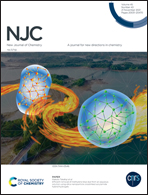The effect of regional selectivity on the corrosion inhibition properties of synthetic ionic liquid via the synergistic action of the cation and anion†
Abstract
By adding different proportions of N-butylimidazole and carboxyethylthiosuccinic acid (CETSA), three hybrid systems of ionic liquids were synthesized and named ILHS1, ILHS2 and ILHS3. Using the weight loss method, electrochemical impedance spectroscopy (EIS), scanning electron microscopy (SEM) and contact angle test, it was determined that ILHS2 had the best corrosion inhibition among the three ionic liquid systems, and that the inhibition efficiency reached up to 90.63% when the concentration was 10 mM in 1 M HCl at 308 K. The adsorption isotherm was consistent with Langmuir adsorption, and combined with molecular dynamics simulation (MD), it was proved that mixed adsorption occurred on the metal interface. Polarization curves showed that the ionic liquid mixture systems could inhibit the corrosion of both poles, meaning that the anions and cations could act synergistically, and that the anions played a major role. The elemental and molecular structures of ILHS1, ILHS2 and ILHS3 were investigated using 1H NMR, which indicated that the three carboxyl groups on CETSA were regionally selective and combined with imidazole cations to form ionic liquid mixture systems.



 Please wait while we load your content...
Please wait while we load your content...